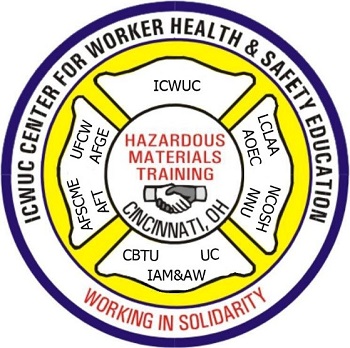Principal Investigator / Institution
-

-
Shari L. Glines-Allen
-
Tel 513-621-8882
Fax 513-621-8247
[email protected] -
ICWUC Center for Worker Health and Safety Education329 Race StreetCincinnati, Ohio 45202-3534
Program Description
Since 1987, the International Chemical Workers Union Council (ICWUC) Center for Worker Health and Safety Education in Cincinnati, Ohio, and its twelve-member union-based Consortium have built a nationally-recognized hazardous materials training program. The ICWUC continues its national multiunion training program to protect a range of collateral duty emergency responders and disaster workers, to protect thousands of U.S. Department of Energy (DOE) workers who are daily exposed to a wide variety of hazardous substances, and to develop a cadre of worker trainers.
The Consortium represents a large constituency of workers across the U.S. in a variety of sectors that will have to contain and clean up hazardous substance releases that occur at their workplaces, from ammonia releases in meatpacking facilities to school or hospital lab spills. The Consortium targets chemical emergency responders and hazardous waste treatment, storage, and disposal facility workers. This includes a wide range of industrial, first-receiver, Spanish-speaking, and government workers and minority community members. The Consortium also provides hazardous materials training to its members in health care who deal with potentially contaminated victims of hazardous substance (including biological agents) emergencies, and public sector employee response teams in a hazardous materials incident.
A strong and experienced train-the-trainer component is integral to all ICWUC Center programs, with almost all educational staff being former worker trainers. The Center has a proud tradition of partnering with many organizations and awardees under all its projects and welcomes the opportunity to work with nontraditional partners.
Hazardous Waste Worker Training Program (HWWTP)
The HWWTP provides environmental health and safety training to workers from a variety of backgrounds – first responders, first receivers, and workers who handle hazardous substances. Site-specific instruction is customized to employer needs. The training accommodates workers with limited English proficiency and is rooted in various adult education techniques. Center staff are authorized to conduct a variety of Occupational Safety and Health Administration (OSHA) classes. We conduct a number of web programs with a range of adult education techniques. The Center will continue and expand the roles of worker trainers in delivering these web classes.
HAZMAT Disaster Preparedness Training Program (HDPTP)
Under the HDPTP, the Consortium trains workers and community members to prepare for and respond to catastrophic events involving hazardous substances. The goal of the project is to have active, informed workers on the front lines of catastrophic releases, disasters and epidemics to recognize the dangers they face, protect themselves, and strive to improve disaster plans. The Consortium develops and uses worker trainers to deliver disaster training designed around participatory adult education techniques, and delivers classes on coordinated disaster assistance, disaster response awareness, incident command, first aid/CPR and automated external defibrillator, OSHA construction standards, OSHA site disaster classes, pandemic, mold, Ebola awareness, and other emerging issues.
The Center also has a program on the U.S. Environmental Protection Agency (EPA) ALOHA and MARPLOT software to model unintentional chemical releases and conducts worker community programs on Occupational Shelter in Place. The Center actively participated in the Katrina, BP oil, Sandy and other hurricane responses by writing new curriculum, delivering awareness classes, and developing train-the-trainer classes. All partners are expanding their efforts to conduct COVID Awareness and COVID Train the Trainer classes.
The evaluation goal is to collect pre/post-training data to assess the impact on workplace changes carried out by trained participants. The investigators will continue to use social networking technology to enhance communication and sharing of resources among trainers and across partners.
NIEHS/DOE Nuclear Worker Training Program
The DOE program trains workers who are, or have the potential to be, employed on demolition, decommission, and decontamination projects at the DOE nuclear weapons facilities. The ICWUC Consortium currently delivers training at four DOE facilities: Hanford, Washington; Oak Ridge, Tennessee; Kansas City, Missouri; and Los Alamos, New Mexico. Workers at these sites are exposed to a variety of hazards – including radiation, heavy metals, solvents, and acid gases – through their normal work, as well as due to significant hazardous waste on-site and releases and other incidents in these aging plants.
The ICWUC implements DOE site training delivered by teams of DOE worker trainers at the four sites. These sites are fully operational and rely on on-site experienced worker trainers (Hanford, Oak Ridge, and Kansas City), while Los Alamos National Laboratory (LANL) uses an experienced local DOE worker trainer. The International Association of Machinists and Aerospace Workers is a significant partner in these efforts, representing members at three of these sites. Classes include a range of Hazardous Waste Operations and Emergency Response (HAZWOPER)-related classes, including a five-day Comprehensive Environmental Response, Compensation, and Liability Act (CERCLA) course; 16-hour bridge classes for workers transferring into regulated areas; and Resource Conservation and Recovery Act (RCRA) classes, with all covered workers taking an eight-hour refresher class annually. There are respirator refreshers at Hanford and fall protection and confined space programs at LANL. Our experienced DOE trainers develop all curricula, evaluate all programs, are subject matter resource experts for hourly and salaried workers, and are trained to use EPA software to model chemical releases.
Project Duration
- August 1, 2020 - May 31, 2025 (HWWTP, HDPTP)
- September 1, 2020 - July 31, 2025 (DOE)
Grant Numbers
- U45 ES006162 (HWWTP, HDPTP)
- UH4 ES009758 (DOE)
Other Participating Organizations
- American Federation of Government Employees (https://www.afge.org/)
- American Federation of State, County and Municipal Employees (AFSCME) (https://www.afscme.org/)
- American Federation of Teachers (https://www.aft.org/)
- Association of Occupational and Environmental Clinics (AOEC) (http://aoec.org/)
- Coalition of Black Trade Unionists (https://cbtu.nationbuilder.com/)
- International Association of Machinists and Aerospace Workers (https://www.goiam.org/)
- International Chemical Workers Union (https://www.icwuc.org/)
- Labor Council for Latin American Advancement (https://lclaa.org/)
- National Council for Occupational Safety and Health (https://www.nationalcosh.org/)
- National Nurses United (https://www.nationalnursesunited.org/)
- United Food and Commercial Workers International Union (http://www.ufcw.org/)
- University of Cincinnati (https://www.uc.edu/)



